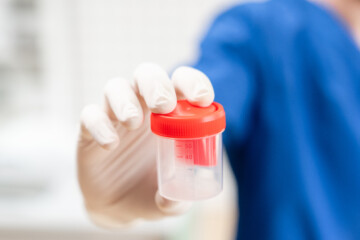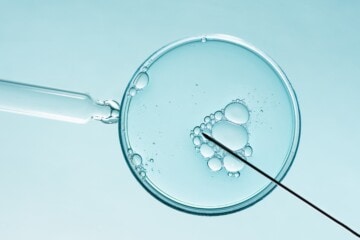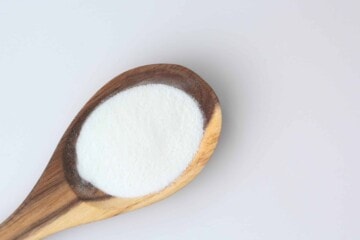If you weren’t a fan of science at school, this title may make you groan. But don’t feel disheartened. We promise to explain as clearly as we can. And we promise that it’s all stuff that’s worth knowing, because it’ll allow you to support your body as best you can. If in any doubt, just take a look at the benefits of myo-inositol for PCOS and the difference it makes to many in our real-life success stories.
Plus, inositol has sparked curiosity for many years — and it’s been around ever since there was life on earth. So, what is this ancient, revered inositol? What’s the difference between myo-inositol and D-chiro-inositol? (why are there so many letters?). And, most importantly: how can they help you?
What is inositol?
It helps to know that ‘inositol’ really should be plural (one for the pedants). It’s actually a group of nine different stereoisomers.
Stereoisomers are natural molecules that have the same formula (numbers of the same kinds of atoms) but differ in chemical and physical properties. These nine different types are found in the lipoproteins of plasma (the clear part of your blood which carries your blood cells), in the phospholipids of your cell membranes and as phosphate in the cell nucleus (the ‘control centre’, so you know it’s important!).
The term ‘inositol’ is generally used to refer to myo-inositol (probably why it’s missing that ‘s’ for plural) as it easily enters your circulation and therefore has the most active effect.
What is myo-inositol?
So what is myo-inositol? (aka inositol). Inositol was first discovered by J. Scherer in 1850 and called ‘inosite’ — a white crystalline substance with a sweet taste. It helps provide structure to your cells as well as influencing the function of chemical messengers in your brain and the hormone insulin. Many years of research found that myo-inositol can help those with PCOS to manage their symptoms as well as support fertility.
Although myo-inositol is found naturally in foods such as beans, fruit, nuts and grains, it’s hard to get enough, and those with PCOS can find it harder to absorb inositol. Inofolic Alpha contains the amount of myo-inositol you need, with the addition of alpha-lactalbumin to help your body to absorb it. If you want to find out more about when to take Inofolic Alpha, we provide information and support.
Start your journey with Inofolic Alpha, today
What is D-chiro-inositol?
D-chiro-inositol is actually produced from myo-inositol. A part of myo-inositol is converted into D-chiro-inositol by the epimerase enzyme. But myo-inositol makes up the bulk of inositols (about 99%), so there’s a lot less D-chiro-inositol around. It’s found in the highest concentrations in the tissues that reserve glycogen — the liver and fat.
D-chiro-inositol helps generate energy from sugar. But the biggest part that it plays in relation to helping those with PCOS is that it also mediates the action of insulin and has a part in the synthesis of insulin-dependent androgen. As well as insulin-related research, it has also been found to potentially aid healthy ovarian function.
What is the difference between myo-inositol (inositol) and D-chiro-inositol?
So, we know what they get up to in your body, but how does this help you? What are the benefits? Let’s take a look.
Their PCOS benefits
There are a number of PCOS treatments out there and myo-inositol supplementation is one of the most effective. There are a multitude of studies – along with research going back over many years – to support the benefits of myo-inositol for those with PCOS. Studies have looked at how myo-inositol can improve PCOS symptoms and outline the benefits for women with PCOS who are using assisted reproductive technologies.
Myo-inositol can also help to relieve symptoms such as hirsutism (excess body hair) and acne, which can impact your mental health and are caused by high levels of androgens. This is because myo-inositol can help reduce the androgens causing you so much trouble.
Those with PCOS also have an imbalance of myo-inositol to D-chiro-inositol, which can lead to irregular periods or no periods at all. Myo-inositol has been shown to reduce male hormones and improve insulin sensitivity, helping to restore regular periods.
Too little myo-inositol and too much D-chiro-inositol can cause a lack of ovulation. Therefore, taking myo-inositol can also help restore ovulation, but if you’re taking D-chiro-inositol too, the right formula is vital, because high doses of D-chiro-inositol can actually prevent your body from absorbing myo-inositol and negatively impact oocytes (eggs). Women with PCOS have also been shown to produce less mature eggs as a result of not having enough myo-inositol.
Unfortunately, PCOS is also a common cause of infertility, which leads us onto…
Their fertility benefits
Myo-inositol has been used to help treat female infertility for many years and this application is backed by a vast amount of research. D-chiro-inositol has also been used in combination with myo-inositol.
Myo-inositol aids fertility in various ways:
- Lowers insulin resistance (helping those with PCOS to conceive)
- Improves fertility when using assisted reproductive techniques
- Manages ovulation hormones
- Improves egg quality
- Prevents issues during pregnancy
D-chiro-inositol also helps to balance your hormones and manage insulin levels, which can aid fertility — but only when taken in combination with myo-inositol.
How they’re used in supplements
Some studies have shown that it’s possible to get inositol from diet alone, but there are too many carbohydrates in these diets for women with PCOS. The carbohydrates turn to sugar and increase your levels of insulin, causing no end of problems. If you have PCOS, you’ll need a slow-carb, low-GI diet. Check out our diet advice for PCOS for more information.
There hasn’t been as much research on D-chiro-inositol, but the consensus is that it won’t help when taken without myo-inositol. And actually, too much D-chiro-inositol can be detrimental to fertility, especially with someone with PCOS.
On the other hand, there are a huge number of studies which provide evidence for the benefits of taking a myo-inositol supplement to help manage PCOS symptoms. Inofolic Alpha contains the dose of myo-inositol you need, along with alpha-lactalbumin to aid absorption. For best results, combine your inositol supplement with a PCOS-friendly diet.
Their chemical structure
Myo-inositol and D-chiro-inositol are nearly identical on a molecular level. If you put them side by side, it’d be impossible for most of us to tell them apart. But if you were to put them on top of each other, you’d notice tiny differences. It’s these differences that mean they play different parts in signalling insulin in your body. D-chiro-inositol is involved in glycogen synthesis and storage, while myo-inositol helps the transporters’ activation and your body’s use of glucose.
Ultimately, you want to know what you’re putting into your body and how it will help you. By learning about inositol before you start taking it and seeing the large body of research into the benefits, you’ll be making an informed choice. Living with PCOS and dealing with issues such as PCOS symptoms and problems with fertility can make you feel powerless. But in fact, the reverse is true: inositol has a powerful effect on all aspects of PCOS.
References:
Ciotta, L. Effects of myo-inositol supplementation on oocyte’s quality in PCOS patients: a double blind trial. Eur Rev Med Pharmacol Sci. 2011 May;15(5):509-14.
Clements, R.S., Jr. and B. Darnell, Myo-inositol content of common foods: development of a high-myo-inositol diet. Am J Clin Nutr, 1980. 33(9): p. 1954-67.
Donne, M et al. Effects of three treatment modalities (diet, myoinositol or myoinositol associated with D-chiro-inositol) on clinical and body composition outcomes in women with polycystic ovary syndrome. Eur Rev Med Pharmacol Sci 2019; 23 (5): 2293-230
Gambioli, R et al. Myo-Inositol as a Key Supporter of Fertility and Physiological Gestation. Pharmaceuticals (Basel). 2021 Jun; 14(6): 504.
Greff, D. Impact of myo-inositol treatment in women with polycystic ovary syndrome in assisted reproductive technologies. Reproductive Biology and Endocrinology volume 21, Article number: 10 (2023)
Greff, D et al. Inositol is an effective and safe treatment in polycystic ovary syndrome: a systematic review and meta-analysis of randomised controlled trials. Reproductive Biology and Endocrinology volume 21, Article number: 10 (2023)
Jamilian H, Jamilian M et al. Comparison of myo-inositol and metformin on mental health parameters and biomarkers of oxidative stress in women with polycystic ovary syndrome: a randomised, double-blind, placebo-controlled trial. J Psychosom Obstet Gynaecol. 2018 Dec; 39(4): 307-314
Kalra B, Kalra S, Sharma JB. The inositols and polycystic ovary syndrome. Indian J Endocrinol Metab. 2016;20(5):720–724. doi:10.4103/2230-8210.189231
Merviel, P et al. Impact of myo-inositol treatment in women with polycystic ovary syndrome in assisted reproductive technologies. Reproductive Health volume 18, Article number: 13 (2021)
Moroni, R.F., et al., The feasibility of a diet which enhances inositol availability. Progress in Nutrition, 2021. 23(2): p. e2021078.
Simi G., Genazzani A. R., Obino M. E. R., et al. Inositol and in vitro fertilization with embryo transfer. International Journal of Endocrinology. 2017;2017:5.









